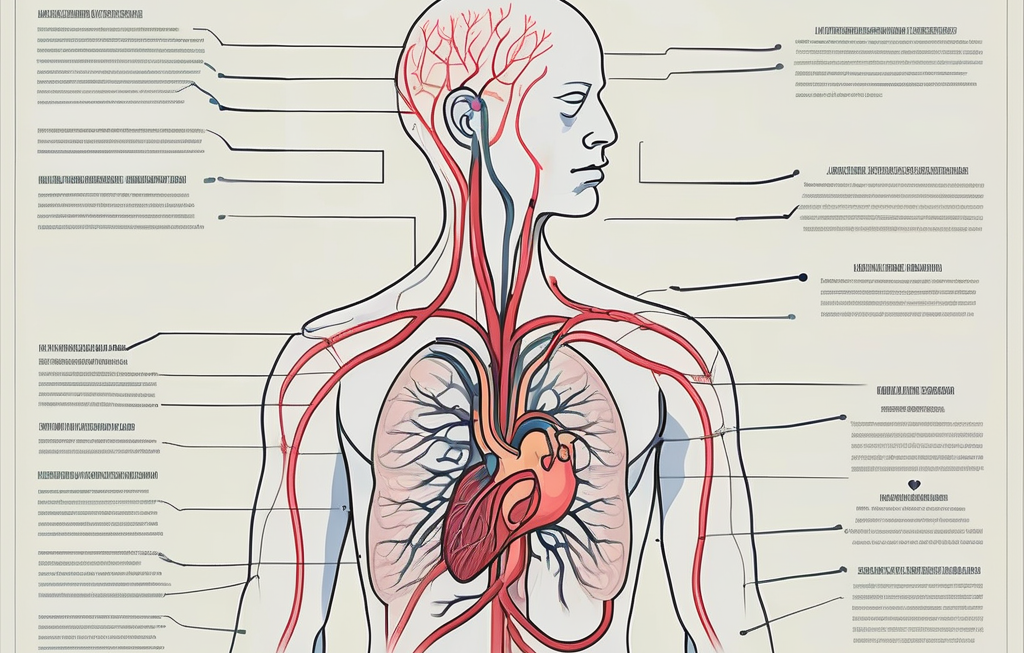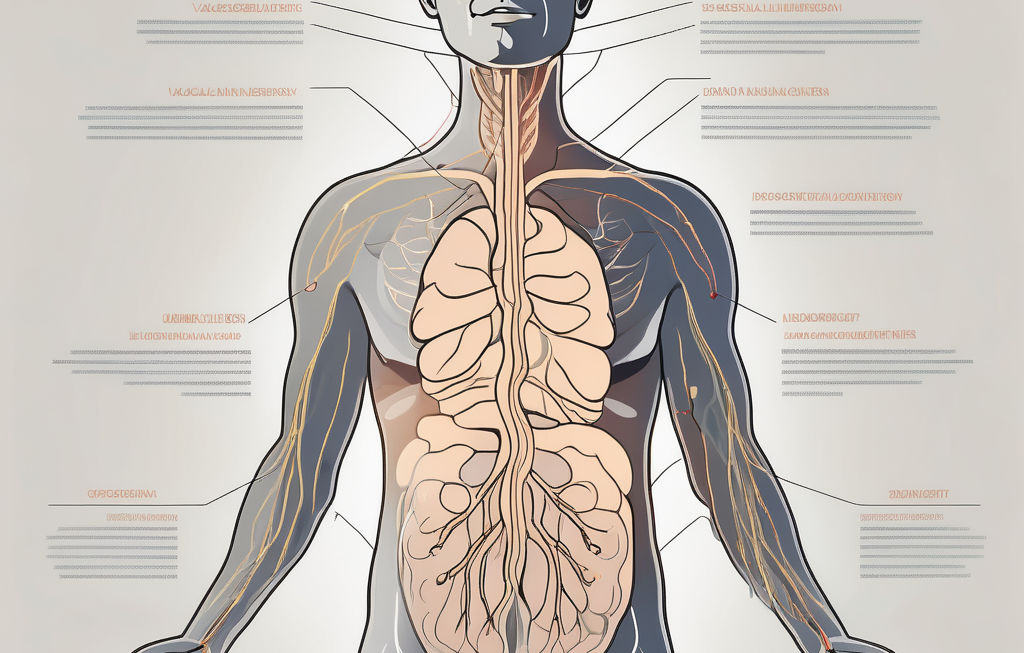The vagal nerve, also known as the vagus nerve, is a crucial component of the autonomic nervous system. It plays a significant role in regulating various bodily functions, ranging from heart rate to digestion. Understanding the anatomy and function of the vagal nerve is essential for comprehending its widespread influence on the body.
Understanding the Vagal Nerve
The Anatomy of the Vagal Nerve
The vagal nerve, also known as the tenth cranial nerve or CN X, is a fascinating structure that extends from the brainstem all the way to the abdomen. It is the longest cranial nerve in the body, and its intricate network of fibers innervates various organs, including the heart, lungs, and digestive system.
Composed of both sensory and motor fibers, the vagal nerve serves as a vital communication pathway between the organs and the brain. The sensory fibers transmit important information from the organs back to the brain, allowing for accurate monitoring and regulation. Meanwhile, the motor fibers carry signals from the brain to the organs, enabling precise control and coordination of their activities.
The Function of the Vagal Nerve
The primary function of the vagal nerve is to maintain homeostasis within the body, ensuring that all systems work harmoniously together. This remarkable nerve constantly monitors and adjusts vital functions to keep them within healthy ranges, especially in response to stress or changes in the external environment.
One of the major roles of the vagal nerve is to regulate heart rate. Through its intricate connections with the heart, it helps maintain a steady heartbeat, making small adjustments as needed to ensure optimal blood flow and oxygen delivery throughout the body. This remarkable ability to fine-tune the heart’s rhythm is crucial for overall cardiovascular health.
In addition to its role in heart rate regulation, the vagal nerve also plays a crucial role in controlling breathing. It works in harmony with the respiratory system, coordinating the various muscles involved in the breathing process. This coordination allows for efficient exchange of gases in the lungs, ensuring that the body receives an adequate supply of oxygen and gets rid of carbon dioxide effectively. Moreover, the vagal nerve influences the diameter of the airways, ensuring proper airflow during inhalation and exhalation, further optimizing respiratory function.
Furthermore, the vagal nerve is intimately involved in the regulation of digestion. It stimulates the release of digestive enzymes and controls the movement of the gastrointestinal tract. This intricate control allows for the proper breakdown and absorption of nutrients, as well as the elimination of waste products. Without the vagal nerve’s influence, the digestive process would be significantly compromised.
Additionally, the vagal nerve has connections with the brain, impacting various cognitive and emotional functions. It plays a role in regulating mood, stress levels, and sleep patterns, showcasing its intricate relationship with mental well-being. This connection between the vagal nerve and the brain highlights the importance of a healthy vagal tone in maintaining overall mental and emotional balance.
The vagal nerve is truly a remarkable structure, with its extensive reach and multifaceted functions. Its intricate network of fibers and its ability to regulate vital processes make it an essential component of our overall well-being. Understanding the vagal nerve’s anatomy and function provides us with a deeper appreciation for the complexity of the human body and the remarkable interplay between our organs and the brain.
The Vagal Nerve and the Heart
Role of the Vagal Nerve in Heart Rate Regulation
The vagal nerve, also known as the tenth cranial nerve or cranial nerve X, is a crucial component in the intricate network that regulates heart rate. This nerve, originating in the medulla oblongata of the brainstem, extends down through the neck, chest, and abdomen, innervating various organs including the heart. Through its connections with the heart’s electrical conduction system, the vagal nerve plays a pivotal role in maintaining a balanced and consistent heartbeat.
When the body is at rest or during periods of relaxation, the vagal nerve dominates the autonomic nervous system, exerting its bradycardic effect on the heart. This effect slows down the heart rate, allowing the heart to conserve energy and optimize cardiac efficiency. In essence, the vagal nerve acts as a natural brake, ensuring that the heart beats at an appropriate pace to meet the body’s needs.
Conversely, during times of increased physical activity or stress, the vagal nerve’s influence diminishes, and sympathetic stimulation takes over. This shift in dominance enables the heart to beat faster and more forcefully, ensuring an adequate supply of oxygenated blood reaches the body’s tissues.
Impact of Vagal Nerve Stimulation on the Heart
Vagal nerve stimulation (VNS) has emerged as a promising therapeutic technique for managing various heart conditions. By delivering controlled electrical impulses to the vagal nerve, VNS can modulate heart rate and improve cardiac function.
Studies have shown that VNS can enhance the efficiency of the heart’s pumping action, increase cardiac output, and improve symptoms in patients with certain cardiovascular disorders. In conditions such as heart failure and arrhythmias, where the heart’s rhythm and pumping ability are compromised, VNS offers a novel approach to restoring physiological balance and enhancing overall cardiac performance.
The Vagal Nerve and the Lungs
How the Vagal Nerve Controls Breathing
The vagal nerve plays a crucial role in controlling breathing patterns. It coordinates the contraction and relaxation of the muscles involved in the process, ensuring the smooth flow of air in and out of the lungs.
When you inhale, the vagal nerve relaxes the smooth muscles lining the airways, allowing for their expansion and the entry of air into the lungs. Conversely, during exhalation, the vagal nerve contracts these muscles, aiding in the expulsion of carbon dioxide from the body.
The vagal nerve’s intricate network extends beyond just the lungs, reaching various organs in the body. It is part of the parasympathetic nervous system, responsible for rest and digest functions. This nerve is involved in a wide range of bodily processes, from controlling heart rate to influencing digestion.
The Vagal Nerve’s Role in Lung Function
The vagal nerve also influences lung function by regulating the production of mucus and the diameter of the airways. It helps to maintain a proper balance, ensuring efficient exchange of gases during respiration.
In certain respiratory conditions, such as asthma, there may be an imbalance in vagal nerve activity. This can lead to bronchoconstriction and increased mucus production, resulting in breathing difficulties. Understanding this relationship is crucial for managing and treating such conditions.
Furthermore, the vagal nerve is not only involved in the physical aspects of breathing but also plays a role in the emotional regulation of respiration. It connects to areas of the brain associated with stress and anxiety, influencing how we breathe in response to different emotional states. This connection highlights the intricate link between our mental and physical well-being.
The Vagal Nerve and the Digestive System
The Vagal Nerve’s Influence on Digestion
The vagal nerve exerts significant influence over the digestive system. It coordinates the release of digestive enzymes, controls the movement of the gastrointestinal tract, and signals the sensation of hunger and satiety.
By stimulating the release of digestive enzymes from the pancreas and other digestive glands, the vagal nerve aids in the breakdown of food into absorbable nutrients. It also helps regulate the movement of food through the digestive system, ensuring efficient digestion and absorption.
Furthermore, the vagal nerve plays a role in signaling hunger and fullness. It communicates with the brain to relay information about food intake and helps regulate appetite. Dysfunction of the vagal nerve can disrupt this signaling system, leading to imbalances in eating patterns and potential weight-related issues.
The Role of the Vagal Nerve in Gut Health
Emerging research suggests a strong connection between the vagal nerve and gut health. The vagal nerve communicates with the gut microbiota, the vast community of microorganisms residing in the digestive system.
Studies have shown that the vagal nerve can influence the composition and activity of the gut microbiota. This bidirectional communication between the gut and the brain through the vagal nerve is known as the gut-brain axis and is believed to play a crucial role in overall health and well-being.
Moreover, recent studies have revealed that the vagal nerve is not only involved in digestion but also in the regulation of immune responses in the gut. It has been found that the vagal nerve can modulate the activity of immune cells in the gut, such as macrophages and T cells, which play a crucial role in maintaining gut health and preventing inflammation.
Additionally, the vagal nerve has been shown to influence the release of various gut hormones, including ghrelin and leptin, which are involved in appetite regulation and energy balance. This intricate network of communication between the vagal nerve, gut microbiota, immune system, and hormones highlights the complex interplay between the nervous system and gut health.
The Vagal Nerve and the Brain
The Vagal Nerve’s Impact on Mood and Stress
Beyond its more tangible physiological effects, the vagal nerve also has a significant impact on mental well-being. It is intricately involved in regulating mood and managing stress.
The vagal nerve helps modulate the release of neurotransmitters, such as serotonin and norepinephrine, which play key roles in regulating mood and preventing the onset of depressive symptoms. Additionally, it helps dampen the stress response by promoting relaxation and reducing the body’s physiological arousal.
Furthermore, recent research has highlighted the vagal nerve’s role in influencing social behavior. Studies have shown that individuals with higher vagal tone, indicating better vagal nerve function, tend to exhibit greater social connectedness and empathy. This suggests that the vagal nerve not only impacts individual well-being but also interpersonal relationships.
How the Vagal Nerve Affects Sleep and Alertness
The vagal nerve also contributes to the regulation of sleep and wakefulness. It helps facilitate the transition between different stages of sleep, including deep sleep and rapid eye movement (REM) sleep.
During sleep, the vagal nerve’s activity increases, promoting relaxation and rest. It helps to restore and reset the body during the sleep cycle. Conversely, during wakefulness, the vagal nerve’s influence decreases, allowing for increased alertness and responsiveness to the external environment.
Moreover, the vagal nerve’s connection to the brainstem and hypothalamus plays a crucial role in regulating circadian rhythms. By influencing the secretion of melatonin, a hormone that regulates sleep-wake cycles, the vagal nerve helps synchronize the body’s internal clock with external light-dark cycles, ensuring optimal sleep patterns and overall well-being.
Disorders Related to the Vagal Nerve
The vagal nerve, also known as the tenth cranial nerve or cranial nerve X, plays a crucial role in regulating various bodily functions, including heart rate, digestion, and speech. Dysfunction or damage to the vagal nerve can lead to a range of symptoms and conditions that impact a person’s quality of life.
Aside from the common symptoms like dizziness, fainting, difficulty swallowing, voice changes, and fluctuations in heart rate and blood pressure, vagal nerve dysfunction can also manifest in less obvious ways. Some individuals may experience gastrointestinal issues, such as bloating, constipation, or diarrhea, as the vagus nerve is intricately involved in gut-brain communication.
Symptoms of Vagal Nerve Dysfunction
When the vagal nerve experiences dysfunction or damage, it can give rise to various symptoms and conditions. These may include dizziness, fainting, difficulty swallowing, voice changes, and changes in heart rate and blood pressure.
It is essential to note that the symptoms of vagal nerve dysfunction can overlap with other medical conditions. A thorough evaluation from a healthcare professional is crucial for accurate diagnosis and appropriate management.
Individuals with vagal nerve disorders may also encounter challenges in regulating their emotions and responses to stress. The vagus nerve is involved in the parasympathetic nervous system, often referred to as the “rest and digest” system, which helps the body relax and recover from stress. Disruption of this system can contribute to anxiety, mood swings, and difficulty coping with everyday stressors.
Treatment Options for Vagal Nerve Disorders
The treatment options for vagal nerve disorders depend on the specific condition and its underlying cause. In some cases, addressing the underlying medical condition or injury may help improve vagal nerve function.
Medications that target heart rate, such as beta-blockers, may be prescribed to manage heart rhythm irregularities associated with vagal nerve dysfunction. Additionally, therapies like vagal nerve stimulation (VNS) can provide relief for certain conditions, as mentioned earlier.
Furthermore, lifestyle modifications, including stress management techniques, dietary changes, and regular exercise, can complement medical interventions in supporting vagal nerve health. Holistic approaches that focus on overall well-being, such as mindfulness practices and yoga, may also benefit individuals with vagal nerve disorders by promoting relaxation and improving autonomic nervous system function.
Overall, a multidisciplinary approach involving medical professionals from various specialties is often utilized to manage vagal nerve disorders effectively. Collaborative efforts aim to optimize individualized treatment plans for each patient’s unique needs.
In Conclusion
The vagal nerve is truly a remarkable structure that innervates multiple organs and systems throughout the body. Understanding its anatomy, function, and role in various bodily processes is crucial for appreciating its widespread influence and potential implications in both health and disease.
While the vagal nerve’s dysfunction can present challenges, ongoing research and advancements in medical science continue to shed light on effective management strategies. Through comprehensive evaluation, accurate diagnosis, and appropriate treatment, healthcare professionals strive to optimize vagal nerve health and overall well-being.



